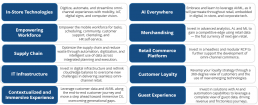How France is Using Technology to Improve Their Rivers
Globally, cities are rediscovering the importance of their rivers as a central tenet of the health, wellbeing, and economy of a city. A river was often, if not always, the reason for a city to develop and grow, but during the 20th century city, authorities began to focus primarily on the built environment and to see water management as a less important sub issue of city management.
With the rise of environmental awareness in the 21st century, cities are beginning to relook at the interrelationship between the built environment and their rivers. We have been tracking this new direction through their research on River Cities and how technology now allows us to instrument both water and the built environment in concert.
According to our research, 28% of local governments across EMEA are already investing in smart rivers with an additional 29% considering investing in the future (IDC Survey, December 2023).
The French are Reclaiming their Rivers
France is emerging as a leader in this process, and the clearest example of this will be the opening ceremony of the 2024 Olympic Games.
Paris is the most visited city in the world, and it is impossible to imagine Paris without picturing the Seine. Olympic opening ceremonies are historically held in a stadium, but France will be using the banks of the Seine for the ceremony to increase participation and celebrate the special relationship between the river and the city.
The Digital Twin Project
A further French example of this new thinking is captured in a recently published IDC Perspective Building a River Digital Twin: A Case Study of the Port de Bordeaux. This document provides an overview of a project led by the Port de Bordeaux, an entity managing marine activities across Bordeaux and the Gironde Estuary.
The objective of the project is to create a digital twin of the Estuary – the largest Estuary in Western Europe covering around 635 km2. The Gironde Estuary is formed from the meeting of the rivers of Dordogne and Garonne and spans several cities, the main one being Bordeaux with more than 250k residents. The Port de Bordeaux manages 7 terminals is the 7th largest French port in terms of traffic.
The digital twin was built to help project participants in both their day-day tactical decision-making process (for example, information on water levels, pollution and navigation) as well as addressing longer-term and strategic challenges (adaptation and impacts of climate change). The Port de Bordeaux developed 8 core goals for the digital twin project:
- Sharing and developing knowledge of the river.
- Promoting the exchange of data and operational results.
- Anticipating the effects of climate change.
- Identifying mitigation solutions.
- Developing economic, recreational and tourism opportunities.
- Preserving biodiversity and environmental wealth.
- Developing coastal and river surveillance (alert systems).
- Fostering replicability of the platform on other rivers.
An innovative aspect of this project is that the project team looked beyond environmental challenges to a broader set of objectives, including, for example, economic and recreational activities. This approach is centred on the view of a river as a complex ecosystem of different stakeholders and an integral part of the identity of the region. The project has a wide target audience, and the use cases, outputs and goals were co-created with the relevant stakeholders at the design stage.
Digital twins are at an early stage of adoption for rivers and marine environments. However, the application of technologies to the blue economy is increasing.
We predict that, by 2027, threatened by water scarcity and extreme weather, 40% of large cities will have digital twins of their water resources to manage water supply, quality, resilience and behavioural change (IDC Smart Cities and Communities 2023 Futurescape).
The Port de Bordeaux is an early adopter and can provide a model and blueprint for others to follow as a core principle of the project was making as many aspects as possible open source. Local stakeholders can upload their own data and use the GIROS platform to visualize their results. This supports a broader community of users being able to take advantage of the model.
Crucially, the Bordeaux project team intentionally designed the solution to be replicable on other rivers; while the numerical model for the Gironde is geographically specific, the framework and architecture of the solution is being made publicly available.
We are soon to publish our first Tech Innovator report on companies involved in rivers and water management and are keen to hear of innovative technology solutions and case studies involving river management for future reports so please do get in touch with us jdignan@idc.com, lbarker@idc.com, rletemple@idc.com
The New Era of FinOps and GreenOps: From Cloud Cost to Sustainability to Business Value
Welcome to the era of xOps where the focus is on sharpening operations capabilities – ranging from visibility to governance to optimization and efficiency for maximizing the business value.
Cloud investments continue to be critical for most organizations, but many are shifting focus to a holistic approach of migration, operations, and optimization under the strategy of CloudOps and governance that also extends to FinOps and GreenOps.
The Ops focus is to optimize and manage applications and services in hybrid cloud through a complex, automated, and governed approach. The goal is to leverage intelligence and AI capabilities to get faster insights into operations to improve efficiency as well as reduce costs and carbon footprint.
Beyond GenAI, cloud costs optimization and sustainability have captured our attention in every conversation with European end-users and cloud vendors in 2023. While cloud costs optimization practices (FinOps) are becoming the norm, sustainability operations (GreenOps) are still at an early stage of maturity, but with Europe leading the path.
This extended focus on GreenOps builds on last year’s FinOps focus highlighted in IDC blog: The Era of FinOps: Focus is Shifting from Cloud Features to Cloud Value.
Why Europe?
European organizations are facing macro-economic uncertainties including inflation, talent-gap, climate crisis, and contention in Eastern Europe. In addition, the new European regulations around sustainability that enter into force in January 2024 (CSRD and ESRS), along with the increasingly sustainability awareness among the young European generation, further puts cloud vendors under pressure.
As a result, IDC’s European CloudOps survey, 2023 (N=1,057) showed that sustainability (37%) and FinOps (31%) are the top two areas that organizations have identified for investment to optimize their cloud operations. We are expecting these results to be even more markable in 2024.
The Future of FinOps and GreenOps in 2024 and Beyond
FinOps and GreenOps remain to be critical in 2024 and beyond. In fact, we expect that by the end of this year, cloud costs and complexity will drive 65% of large organizations in EMEA to increase their maturity with optimization practices, resulting in 2X greater efficiency and cost effectiveness than all organizations.
We believe there are huge opportunities for cloud vendors in both spaces. Enabling organizations with FinOps capabilities can help customers get a better understanding of their cloud spending trends in order to optimize the spend, bring transparency and accountability, and boost ROI from investments.
GreenOps, on the other hand, can bring capabilities to reduce the environmental footprint in the cloud. GrenOps also involves practices like waste reduction, switching off resources, and the transition to renewable energy, but also promoting a new company culture with a greater environmental responsibility.
Conclusion
Despite different objectives, the two approaches must go hand in hand as one is a big contributor to the other, and vice versa. The CloudOps community also agreed that providing granular data across cloud costs and carbon footprint (scope 1, 2, and 3), along with tailored insights and recommendations, would play a critical role in enhancing cloud vendors’ competitive advantage.
Furthermore, cloud providers need to be meticulous in measuring data, sharing what they have included and excluded, and providing data metrics. Finally, cloud vendors should also educate stakeholders, especially in less mature markets like GreenOps, resulting in a greater trust with their customers.
Stay tuned on the new EMEA CloudOps research and survey and join us on Tuesday, January 23rd, at 11am GMT, where we will discuss the new IDC FutureScape 2024: European Cloud, including trends and opportunities around FinOps and GreenOps.
3 Future of Work Predictions for 2024 and Beyond - Through the Looking Glass
After much back-and-forth on work models, bold ultimatums from employers and staunch resistance from workers, European businesses are in the process of codifying different ways of where, how, when, and why we work. One of the many reasons for this change is the speed with which technology, especially artificial intelligence and GenAI, have made it possible to work equally well in varying, flexible work models.
The downside of this rapid technology development has been that European organizations simply cannot hire enough workers with current or deep skills – both technical and human. Do you manage highly distributed teams performing complex and interdependent tasks? Certainly not easy. Finding employees trained sufficiently well to safely transition to the use of Gen AI solutions? Not easy either.
Enter the promise of automation and in particular the ability of AI and Gen AI tools to both facilitate repetitive tasks like coding, data entry, research, and content creation but also to amplify the effectiveness of learning in the flow of work and secure company assets.
The following 3 predictions are examples of what work in Europe might look like in the next five years, considering the areas of work personalization, skills development and the impact of climate change on office design.
Future of Work Predictions for 2024 and Beyond
- Prediction 1: 60% of Large Businesses will upgrade hardware and software technologies to increase worker retention with personalized work experiences and enhanced collaboration by 2025.
Rapidly evolving technologies and work methods are forcing companies to upgrade hardware and implement new software technologies that support better employee experiences, personalization and improved collaboration.
Collaboration apps are becoming more visual and continue to develop features unlike multiplayer games that enable a more personalized view of work and teams, better targeting of projects, and hands-on collaboration apps. Meetings and other work resources, including collaboration resources (workflow, meetings, new document formats, etc.) are translated and transcribed in real time, captured, analyzed and exploited by other integrated business data sources. The results enable faster and more personalized decisions and collaboration, including summaries using generative AI. AI solutions are gradually increasing the ways people consume content and data, and AI itself will become a digital collaborator.
- Prediction 2: Enterprises will leverage personalized technology skills development to drive $1T in productivity gains by 2026, enabled by GenAI and automation everywhere.
As the development and use of technology in everyday work environments becomes more complex, organizations struggle to find experts for programming, security, architecture, operations, management and many other roles. IDC data from 2023 shows that 43 % percent of organizations lack the capability support needed to successfully implement automation.
One of the reasons Gen AI adoption and experimentation has grown so rapidly is that everyday workers can see its immediate value. As new jobs come online due to new automation requirements and workers learn new skills, Gen AI is being incorporated into tools that create employee training. Workers with entry-level skills can better target individual learning needs based on the speed with which Gen AI can generate code, summarize data, and create first-draft multimedia products. This customized approach ensures that people (including IT staff) receive the most appropriate training, optimizing efforts to increase their skills and competencies as jobs evolve, plus the need to program GenAI applications themselves.
- Prediction 3: By 2028, organizations will invest in office climate havens, using asset-based/renewable energy to defray 30% of their ongoing operating costs.
It is not just work patterns that are rapidly changing. The environment we live and work in is rapidly changing too. As uncontrolled wildfires, climate change and extreme weather events become more common in Europe, the consequences are affecting human health and the ability to work effectively. Sustainability measures are no longer considered optional as organizations worldwide recognize them as necessary components of strategic planning and sustainable operational excellence.
In future, progressive companies will adopt a combination of innovative building design, digital twins, robotics and integrated climate systems to create climate havens where workers and their families can both find relief and focus on work. Unfortunately, simply rebuilding existing buildings with AI or robotics adds energy demand to an already struggling European energy infrastructure.
Companies that invest heavily in asset-based energy (hydro/tidal, geothermal, solar and wind) on-site in their climate havens, support both their operating costs and potentially create a secondary revenue stream when they feed electricity back into the grid. This is reversing the long-term trend of digital organizations threatening their local communities through excessive power usage, while improving community relations, employee retention and talent recruitment.
All the above predictions have much in common – they seek to better understand the intersection of technology and human behavior. Science fiction predicts dystopian visions of mechanized and artificially controlled societies where human efficacy is threatened. IDC far from that point of view, but we also see how the concerns raised by new technologies such as Gen AI can play a big role in hindering adoption—for better or for worse.
Organizational leaders must invest time and money in the strategic planning for the adoption of AI and GenAI technologies, as well as the new roles and ways of working they create. This is not just a technology issue that affects computing, security, hardware, infrastructure, and integration requirements. It is also a human issue that must be addressed employee empowerment through skill development and the development of appropriate, re-imagined career paths.
For more information on the impact of Automation on the European Future of Work, please access the following resources:
- Five Ways to Unlock a Purposeful, Automated Future of Work in EMEA – watch now
- IDC EMEA FutureScape 2024: Reimagining an AI Everywhere Digital Future- https://goto.webcasts.com/starthere.jsp?ei=1635711&tp_key=4edfcb9432&sti=website
Ready for NRF 2024: 10 Imperatives for Success in Retail
NRF24 Retail’s Big Show in New York City is fast approaching, and we, IDC Retail Insights will be there. We cannot wait to talk with retailers, technology companies, and industry experts, share our views and learn more about what matters for the industry in 2024 and beyond.
As we prepare for the event, let’s summarize the critical technological imperatives that retailers must embrace to thrive in today’s ever-evolving business environment. Our insights are drawn from IDC Retail Insights’ Global Retail Survey 2023, where over 800 retailers worldwide shared their strategic priorities. Let’s dive into it!
Multilevel Loyalty Strategy for a Greater Retail and Customer Experience
We predict that “by 2024, 40% of Retailers Will Adopt a Multilevel Loyalty Strategy, Leveraging a Unified View of the Customer, to Increase Retention Rate by 20% and Net Promoter Score by 35%”. Retailers worldwide are on the brink of customer loyalty revolution, with a staggering 35% gearing up to unveil cutting-edge multilevel programs within just three years, as revealed by IDC’s 2023 Global Retail Survey.
The once-reliable methods like points and promotions are losing their edge, lacking the spark needed to captivate customers. Now, in an era where privacy regulations tighten and accessing third-party data becomes limited, the game-changer lies in collecting firsthand customer data—it’s the cornerstone of tomorrow’s success.
But the game is evolving, and the retail world is diving headfirst into the realm of immersive tech. By embracing this tech-savvy frontier, retailers can elevate loyalty strategies, crafting experiences finely tuned for the ever-evolving Alpha and Gen Z consumers.
Brands like Ralph Lauren and Lacoste are venturing into Web3 for exclusive immersive experiences and community building.
The real challenge is about seamlessly delivering these immersive experiences across every retail touchpoint, navigating a landscape growing more complex by the day. That’s why empowering workforce with digital tools isn’t just essential; it’s a key differentiator for maintaining contextualized customer experiences.
Meanwhile, in the hospitality sector, a digital revolution is reshaping the guest experience, demanding personalized, predictive experiences despite ongoing labour shortages. This calls for a strategic fusion of systems and capabilities, a dynamic approach to cater to the digital-driven needs of today’s guests.
Investing in Technology to Deliver Efficiencies and Effectiveness in the Omnichannel Customer Journey
Retailers are navigating challenging a business environment and are under pressure to increase revenue and reduce costs. According to our IDC Global Retail Survey, while customer experience is at the top of retailers’ concerns, increasing operational efficiency is the second most important business priority for retailers.
This is mainly due to the greater complexity of the business environment the industry faces.
Let’s consider, for example, the role of brick-and-mortar in today’s omnichannel operations. The physical store is the pillar of retail operations today, but it must be connected and fully integrated with digital operations to play its role as the centrepiece of the customer journey.
One strategic imperative for retailers is investing in in-store Technology, such as AI, Computer Vision, and IoT, to digitize, automate, and streamline the omnichannel experience in-store.
While retailers are navigating challenging territories and need to do more with less, they haven’t stopped investing in technology. Top investment areas in 2024 include physical infrastructure, cloud, and managed services.
Therefore, another digital transformation imperative is investing in IT Infrastructure, including network infrastructure to connect the physical store and rethink cloud and edge balance to provide a seamless omnichannel experience.
A transformation imperative that should not be overlooked to streamline the efficiency of retailers’ operations is linked to the importance of embracing a best-of-breed Retail Commerce Platform. Retailers are investing in modular and headless platforms, to move towards composable architectures that match the needs of modern omnichannel retail.
As we can see, retailers should be laser-focused on the technological imperatives that make omnichannel operations more efficient and in turn generate better omnichannel customer experience.
AI and Augmented Reality for Customer Experience
In today’s landscape, AI is everywhere as it’s revolutionizing how consumer brands approach customer experiences. This shift places a heightened emphasis on human-centric approaches, especially as AI and GenAI streamlines routine tasks.
In this augmented context, organizations are placing a premium on customer empathy, trust, and privacy. However, this requires a fundamental leadership’s cultural shift and a business transformation, detached from traditional hierarchies towards flatter structures, identifying shared metrics, and nurturing a collaborative culture where innovation thrives.
Retailers growing attention to and investment in advanced analytics, AI, machine learning (ML), and natural language processing (NLP) are unlocking and demonstrating the potential of generative AI (GenAI). It is a point of no return, where retailers are shifting from being merely data-rich to strategically data-driven organizations.
Omnipresence across different channels, such as social media networks, marketplaces, ecommerce, in combination with personalized engagements allow retailers to extract real-time value from every interaction. AI’s impact on CX personalization is profound, evolving from static segments to real-time, context-driven experiences.
The depth of coherent customer data leverages the integration of AI and ML analytics, notably in predictive product recommendations. Our IDC’s 2024 Retail Predictions say that “by 2028, 50% of retailers will offer AI-enabled contextualized recommendations to enhance customer engagement, increasing real-time interactions by 30% and overall conversion rate by 20%”.
These AI algorithms amplify omni-channel strategies, empowering both store associates and digital agents for seamless customer engagements as well as contextualized marketing and merchandising. AI isn’t merely a buzzword; it’s a game-changer. Particularly, it’s reshaping new revenue streams, such as Retail Media Networks, facilitating and powering orchestration across interconnected systems, aiming to seamlessly handle pricing, inventory, forecasting, planning, and maintain consistency across channels and partners.
Importance of the Supply Chain on the Customer Journey and Sustainability
Retail logistics have seen a few challenges in recent years, including disrupted sourcing streams and workforce shortages, but supply chains have started to readjust. Despite things getting better, retailers are preparing for the future by anticipating challenges like those experienced in the recent past, and now investing in making the Supply Chain even more resilient through greater automation and data insight has become a digital transformation imperative.
The primary reason for investing in the supply chain is to increase efficiency and improve product availability, resulting in a better omnichannel customer experience. Sustainability is also a big factor in retailers’ strategic imperatives related to improving the efficiency of the supply chain.
Fortunately, these two objectives—efficiency and sustainability—are not in conflict with each other. Investing in supply chain efficiency has the potential to reduce costs, improve customer experience, and make operations more sustainable.
Retailers are taking a proactive approach to address the challenges of the future. By investing in supply chain resilience, they are ensuring that they can continue to provide the best possible customer experience while also being mindful of the environment.
Let’s Meet at NRF!
As we anticipate key themes for IT vendors and retailers in 2024, we expect these 10 Imperatives for Success to be prominent topics in our conversations at NRF in January. If you’re attending NRF, reach out to us to arrange a meeting or visit our booth at number #1032.
We look forward to meeting you there!












